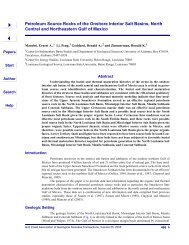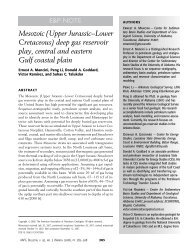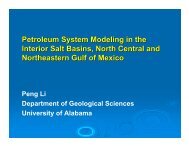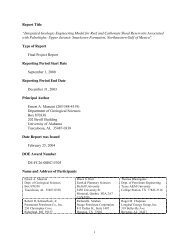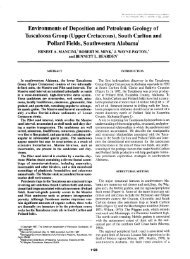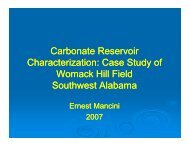Part 4 - Berg - Hughes Center
Part 4 - Berg - Hughes Center
Part 4 - Berg - Hughes Center
You also want an ePaper? Increase the reach of your titles
YUMPU automatically turns print PDFs into web optimized ePapers that Google loves.
Maps of present day heat flow (Fig. 83), of lithospheric stretching beta factors (Fig. 84),<br />
and plots of vitrinite reflectance values (Figs. 85-86) were prepared to assist with this<br />
analysis. The generation of hydrocarbons from Smackover lime mudstone was initiated<br />
at 6,000 to 8,500 feet during the Early Cretaceous and continued into the Tertiary, using a<br />
transient heat flow model (Table 1). Organic carbon contents of up to 1.80% have been<br />
recorded from the Smackover for this basin. The dominant kerogen types in the<br />
Smackover are amorphous and microbial with herbaceous. These Smackover lime<br />
mudstone beds exhibit thermal alteration indices of 3 - to 3 + . Hydrocarbon expulsion from<br />
Smackover source rocks commenced during the Early Cretaceous and continued into the<br />
Tertiary with peak expulsion chiefly in the Early to Late Cretaceous.<br />
Basin Modeling and Petroleum System Identification<br />
Basin modeling is crucial to petroleum system identification. In basin modeling,<br />
regional hydrocarbon flow patterns generally are discerned from two-dimensional<br />
models. Petroleum system characterization assists in the recreation of the history of the<br />
hydrocarbons within a specific geologic system in a basin. Knowledge of the petroleum<br />
system can greatly facilitate the development of improved exploration strategies for<br />
hydrocarbons in a basin. From the basin modeling and petroleum system characterization,<br />
petroleum systems identified as potential for the North Louisiana Salt Basin have been<br />
identified for this study.<br />
The burial and thermal maturation histories of the strata in this basin are consistent<br />
with its rift-related geohistory. Source rock analysis and geohistory, thermal maturity and<br />
hydrocarbon expulsion modeling indicate that lime mudstone of the Upper Jurassic<br />
Smackover Formation served as an effective regional petroleum source rock in the North<br />
385




